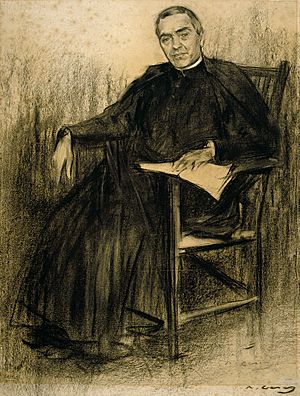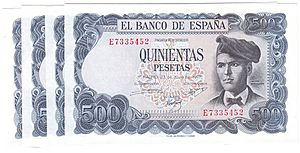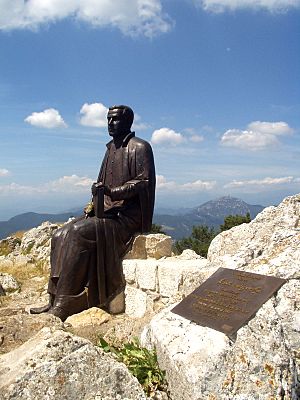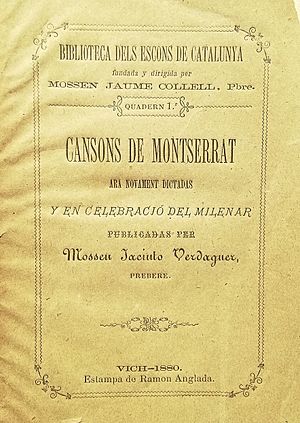Jacint Verdaguer facts for kids
Quick facts for kids
Jacint Verdaguer
|
|
|---|---|

Verdaguer as seen by Ramon Casas in 1901 (MNAC)
|
|
| Born | 17 May 1845 Folgueroles, Spain |
| Died | 10 June 1902 (aged 57) Vallvidrera (Barcelona), Spain |
| Occupation | Poet, priest |
| Literary movement | Renaixença, Romanticism |
| Notable works | Canigó, L'Atlàntida |
| Signature | |
 |
|
Jacint Verdaguer i Santaló (Catalan pronunciation: [ʒəˈsim bəɾðəˈɣej səntəl'o]; born May 17, 1845 – died June 10, 1902) was a famous Catalan writer. He is known as one of the greatest poets in the Catalan and a key figure in the Renaixença. This was a cultural movement that helped bring back Catalan traditions and language. People also called him mossèn Cinto Verdaguer because he was a priest.
Contents
Jacint Verdaguer's Early Life
Jacint Verdaguer was born in Folgueroles, a small town in Spain. His family was not rich, but they valued learning. His father, Josep Verdaguer i Ordeix, was a bricklayer and farmer. His mother, Josepa Santaló i Planes, was a housewife and farmer. She loved literature and was very religious, and she passed these loves on to young Jacint.
Jacint was one of eight children, but only three survived. When he was 10, in 1855, he started studying at the Seminary of Vic. This was common for younger sons who needed to find a way to make a living. Even as a child, Jacint was known for being smart, clever, and brave. He was also athletic and seemed well-balanced.
Becoming a Writer and Priest
In 1863, at 18, Jacint began working as a tutor for a family at a farm called Can Tona. He also helped with farm work while continuing his studies.
His talent for poetry was noticed early. In 1865, he entered the Jocs Florals (Floral Games) poetry contest in Barcelona and won four awards. The next year, he won two more prizes at the same contest.
On September 24, 1870, he became a priest in Vic. He held his first Mass in the Sant Jordi hermitage. Soon after, his mother passed away in 1871. He then became a priest's assistant in the town of Vinyoles d'Orís.
Verdaguer's Important Works
In 1873, Jacint published a long poem called "Passió de Nostre Senyor Jesucrist" (Passion of Our Lord Jesus Christ). He left Vinyoles d'Orís due to health issues and moved to Vic. He took a trip to Roussillon, where he likely saw the Canigó mountain for the first time.
Because sea air was recommended for his health, he became a chaplain for a trans-Atlantic steamship company in December. He traveled from Cádiz to Havana.
L'Atlàntida and Fame
While returning from Cuba on a ship, Jacint Verdaguer finished his famous epic poem, L'Atlàntida. In 1876, his father died. In November, he started working as a chaplain for the Marqués de Comillas.
In 1877, when he was 32, the judges of the Jocs Florals gave him a special prize for L'Atlàntida. This made him a very well-known poet.
In 1878, he visited Rome and met Pope Leo XIII. They talked about his poem L'Atlàntida. In 1880, he won three more prizes at the Jocs Florals. This earned him the title "Master of the Gay Sciences" (Mestre en Gai Saber). That same year, he published his poetry book, Montserrat. This book included "Llegenda de Montserrat," a poem about the sacred mountain of Montserrat.
Later Life and Challenges
In 1883, the Barcelona City Council printed 100,000 copies of his poem "Oda a Barcelona" (Ode to Barcelona). This was a huge number for the time, showing how popular he was. At 39, Verdaguer traveled to Paris, Switzerland, Germany, and Russia.
His poetry collection Caritat (Charity, 1885) was published to help raise money for people affected by an earthquake in Andalusia.
On March 21, 1886, when he was 41, Bishop Morgades honored him as the 'Poet of Catalonia' in the monastery of Ripoll. He published another epic poem, Canigó, and made a trip to the Holy Land.
In 1893, Jacint faced some difficulties in his role as a priest and left his position at the Marquis of Comillas' palace. He completed his trilogy of books called Jesús Infant. For a time, he was not allowed to perform his duties as a priest, but this was later changed. In 1894, his books Roser de tot l'any and Veus del bon pastor were published.

Death and Legacy
On May 17, 1902, his 57th birthday, Jacint Verdaguer moved to a country house called Vil·la Joana in Vallvidrera, near Barcelona. He hoped to get better there, but he passed away on June 10, 1902. Vil·la Joana is now a museum.
Verdaguer was buried in Montjuïc Cemetery in Barcelona. He was so important that his image was even put on the Spanish 1971 500 Pesetas banknote.
Selected Works
Here are some of Jacint Verdaguer's most important works:
- L'Atlàntida (Atlantis, 1876), a long poem telling a story.
- Idil·lis i cants místics (Idylls and Mystic Songs, 1879), a book of poems.
- Montserrat (1880, 1899), poems about the Montserrat mountain.
- "A Barcelona" ("To Barcelona", 1883), a long poem about the city.
- Caritat (Charity, 1885).
- Canigó (1886), another epic poem.
- Sant Francesc (Saint Francis, 1895).
- Flors del Calvari (Flowers of Calvary, 1896).
The famous composer Manuel de Falla created a large musical piece called Atlàntida, which was based on Verdaguer's poem L'Atlàntida. De Falla thought this was his most important work.
Some of Verdaguer's shorter poems are still very popular songs in Catalonia, like "L'Emigrant" ("Sweet Catalonia, country of my heart...").
See also
 In Spanish: Jacinto Verdaguer para niños
In Spanish: Jacinto Verdaguer para niños
- Pi de les Tres Branques, a tree made famous by Verdaguer as a Catalan symbol.
- Verdaguer House-Museum in Folgueroles.
- Barcelona City History Museum and its Vil·la Joana House.




